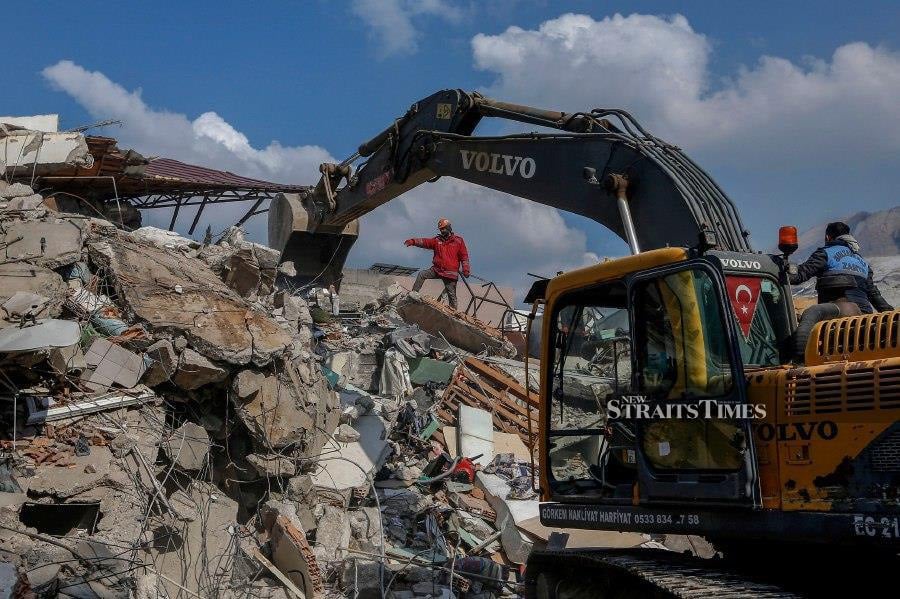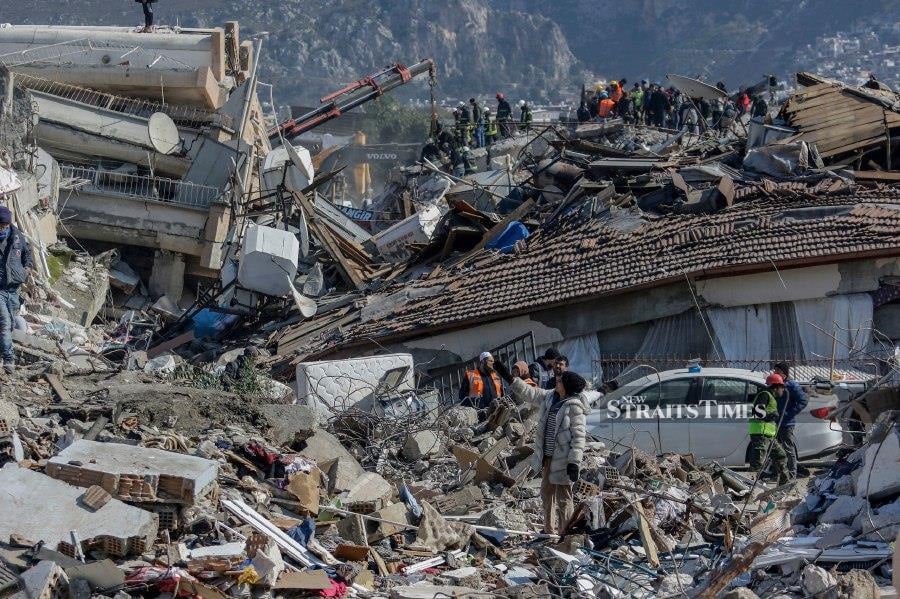KUALA LUMPUR: As the first anniversary of the devastating earthquake in Türkiye comes to pass, the scars of the catastrophe are still painfully visible in Nirdagi, one of the hardest hit districts.
Here, amid ongoing reconstruction, we encountered Mehmet Sohyu, a father of four, navigating the remnants of what was once his home alongside his children.
As Mehmet guided us through the reconstruction area, his demeanour masked the haunting memories that lingered from the night of Feb 6, a year ago.
Recounting the harrowing experience, he revealed the heart-wrenching moment when his home crumbled under the force of the earthquake, trapping his children beneath the rubble.
With tears welling in his eyes, Mehmet shared the agonising hours spent waiting for rescue, clinging to hope as prayers echoed through the chaos.
Miraculously, his children emerged from the debris, defying the odds and escaping the clutches of death. Even so, the trauma of that fateful night continued to haunt Mehmet, replaying like a relentless nightmare in his mind.
"It's as if time stood still, and I'm trapped in that moment of terror," he confessed, his voice tinged with anguish.
Beyond his own struggles, Mehmet voiced concern for the mental well-being of his children, grappling with the aftermath of the disaster. The psychological scars ran deep, leaving an indelible mark on their young minds.
"I worry about their resilience, their ability to heal from the trauma they've endured," he confided, his paternal instincts in overdrive.
Mehmet found solace in the support extended by the state, acknowledging the crucial role of psychosocial assistance in aiding their recovery.
"The assistance provided has been a lifeline for us, offering a beacon of hope in our darkest moments," he reflected.

As we bade farewell to Mehmet and his family, their resilience echoed through the quiet reconstruction site, a testament to the human spirit's capacity to endure and rebuild even in the face of adversity.
As Türkiye marks the anniversary of the earthquake, the journey towards healing and reconstruction continues, fueled by the resilience of its people and the unwavering commitment to rebuild what was lost.
The epicentre of the earthquake was in Kahramanmaraş, but the province of Hatay, which borders Syria, suffered the most. It accounted for nearly half of the total number of casualties (over 23,000 people), and around 80,000 buildings were destroyed or severely damaged here.
In total, over 800,000 structures were destroyed in Türkiye, including more than 676,000 houses and 115,000 commercial buildings and enterprises. According to the United Nations (UN), about 1.5 million people were left homeless.
Initially, new buildings collapsed, including elite residential complexes; it was later revealed that many of them were constructed with design flaws and serious violations of building regulations.
The house of 61-year-old Kahraman Kanat from the city of İskenderun did not survive. "It felt like the world turned upside down. We miraculously managed to run outside," he told NST.
Like thousands of other victims, Kahraman lives in temporary housing made from shipping containers. Currently, there are 414 container cities operating in Türkiye, accommodating approximately 579,000 people.
Over time, they have acquired minimal infrastructure - mosques, small clinics, grocery stores with subsidised prices, and community centres with kindergartens, libraries, and schools.
In total, the earthquake affected 14 million people in 11 provinces in the south and southeast of Türkiye—Adana, Adıyaman, Diyarbakır, Elazığ, Hatay, Gaziantep, Kahramanmaraş, Kilis, Malatya, Osmaniye, and Şanlıurfa.
According to a report by the Turkish Economic Policy Research Foundation (TEPAV), 40 per cent of buildings in the earthquake zone suffered minor, moderate, or severe damage, or collapsed completely. Economists estimate that at least US$150 billion (RM701 billion) will be needed for the country's reconstruction over the next five years.
The capital of Hatay province, Antakya (known as Antioch in antiquity), was almost completely destroyed. Due to powerful aftershocks, not only residential buildings but also the local high school collapsed.
Now its students and teachers live on a ferry, which used to operate between England and Ireland. The ferry was bought by the Turkish energy company Karadeniz Holding and converted into a dormitory.
The "Floating Academy," moored in the port of İskenderun, is designed to accommodate 1,200 people and equipped with a dining hall, separate dormitories for boys and girls, classrooms, a library, and recreational areas.
Throughout all four years of education (from 9th to 12th grade), the company provides students with a monthly scholarship of 600 lira (just under RM100). Meanwhile, for graduates of the "floating academy" who enter university, scholarships range from 1,200 to 5,000 lira (RM150 to RM800) depending on academic performance.
Zeynep Şahin, the coordinator of the academy's educational programmes, explained that almost all students have lost someone close to them, with their families living in container cities. Psychologists regularly work with the children, and classes are even held in the evenings.
"Living in a container was unbearable"
The majority of residents in the container cities located in the provinces of Hatay and Gaziantep, whom the NST correspondent had the opportunity to interview, expressed gratitude towards the authorities for providing shelter during the winter months. However, they admitted that life becomes increasingly difficult with each passing month.
An elderly woman, who preferred not to disclose her name, showed the NST correspondent the leaking roof and deteriorating floor in her container home.
Her husband lost his leg during the earthquake, making even minor repairs in their temporary shelter challenging for them. Consequently, they are eagerly awaiting the new homes promised by the authorities.
Just four days after the earthquake, Turkish President Recep Tayyip Erdoğan declared that all those affected would be provided new homes within a year.
On Feb 3 and 4, 2024, shortly before the first anniversary of the devastating disaster, the first families received keys to their new apartments.
In the province of Hatay, 7,275 houses were constructed, with plans to deliver another 75,000 within the next two months. Similarly, in the Islahiye district of the neighbouring Gaziantep province, which was also significantly impacted by the disaster, the occupancy process for the first 10,700 houses has commenced.
"We see that Türkiye is swiftly healing the wounds inflicted by the devastating disaster, demonstrating the solidarity of the century," stated the Turkish leader at the solemn ceremony.
In total, 307,000 new houses are planned to be built in urban and rural areas across the 11 affected provinces.
Authorities promise that all of them will be earthquake-resistant. The foundation for the first multi-storey buildings in Islahiye was laid just two weeks after the earthquake, on Feb 20, 2023.
"We're trying to erase the earthquake from our memories"
In the provinces most impacted by the earthquake, signs of widespread destruction are still evident. During a visit by an NST correspondent to Gaziantep, Islahiye, İskenderun, and Antakya, partially collapsed buildings and heaps of debris from demolished structures line the streets.
"We had to clear rubble in an area equivalent to the size of a small country," said Gaziantep Governor Kemal Cheber at a briefing for foreign journalists. His colleague from Hatay, Mustafa Masatlı, compared the aftermath of the earthquake in his province to "the explosion of 2,000 atomic bombs."
Significant damage was also inflicted on historical monuments. In Gaziantep, several sections of walls and towers of the city fortress, built in the Roman Empire era in the 2nd to 3rd centuries AD, collapsed.
In Antakya, underground shocks destroyed the Protestant church, synagogue, Greek Orthodox church, and several mosques, including the oldest in all of Anatolia, Habib-i Najjar, built in the 7th century as a pagan temple. In Diyarbakır, the eponymous fortress and Hevsel Gardens, listed as Unesco World Heritage Sites, suffered severe damage.
Turkish authorities assure that they have enlisted specialists for the restoration, who have catalogued literally every fragment of ancient structures and have already begun careful restoration work.
Before the earthquake, about half of the 3.6 million Syrian refugees living in Türkiye found shelter in the affected provinces. Most of them were in Gaziantep, the capital of its namesake province and one of the country's main industrial centres, located just 100 kilometres from Aleppo, Syria.

The Governor of Gaziantep told NST that the province currently hosts 425,000 Syrians. According to him, the authorities treat them the same as other residents of the region; those who wish can start their own businesses, send their children to school, and receive other services from the state. "They are no different from ordinary Turkish citizens in terms of living conditions," Cheber said.
According to the UN and the Turkish Red Crescent, some Syrian refugees, left without homes and sources of income, preferred to move to other regions of Turkey or return to their homeland, where the civil war is still ongoing. This is especially noticeable in Hatay and Şanlıurfa.
"Psychologists and psychiatrists advised us to dissociate our city from this disaster.. Therefore, we are trying to erase the earthquake from our memories - physically, economically, and psychologically," says Kemal Cheber.
The efforts of the authorities are bringing results in physical and economic terms: new neighbourhoods are growing from the ruins, and the export of goods from the 11 affected provinces for January of this year even exceeded last year's figure by 2.3 per cent.
Dealing with the psychological consequences of the natural disaster will take much longer - memories of the experience and fear that it may happen again remain deeply ingrained in society. Ayşel Bozgeyik from Nurdagi, who lost her brother in the earthquake, still hears the noise that woke her up early in the morning on Feb 6, 2023. "The underground shocks lasted only a minute and a half, but it felt like an eternity," she sighs.
Trader Yusuf Mekikçi from Gaziantep recalls that in the first few days, the situation in the city was catastrophic. "There was no bread, no water, nothing. Everything was closed. It's not even like that in war," he remembers.
As Türkiye commemorates the anniversary of the earthquake, the ongoing journey of healing and reconstruction underscores both the resilience of its people and the enduring impact of the disaster.





